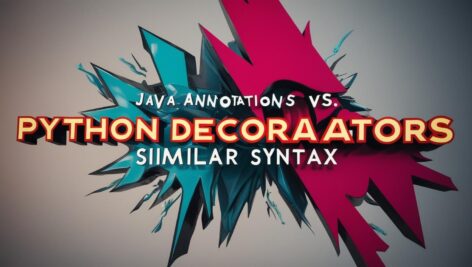Java annotations and Python decorators might look alike thanks to the @ symbol, but under the hood, they serve very different purposes. In this article, we break down how they work, where each shines, and why Java annotations often stir debate among developers.
The Surface Similarity That Misleads
At a glance, Python decorators and Java annotations appear to do the same thing—both start with @ and sit above functions or methods:
Python Decorator Example
@measure
def slow_func():
sleep(0.7)
Java Annotation Example
@Override
void method() {
System.out.println("method");
}
That’s where the similarity ends. The meaning and behavior behind the @ symbol are fundamentally different in each language.
Python Decorators: Functional and Explicit
Python decorators are higher-order functions. They wrap other functions or classes, adding or modifying behavior in a transparent and predictable way.
def measure(func):
def wrapper(*args, **kwargs):
start = time()
result = func(*args, **kwargs)
print(f"Time: {time() - start}")
return result
return wrapper
@measure
def slow_func():
sleep(0.7)
Here, @measure is just syntactic sugar. You could just as easily write:
slow_func = measure(slow_func)
Why Python Decorators Work Well
- Clear logic: Everything is in plain sight.
- Highly flexible: You can decorate functions, classes, or even parameters.
- No external tooling required: Everything works with pure Python.
Java Annotations: Metadata for Frameworks
Java annotations, on the other hand, do not execute code. They serve as metadata for tools, frameworks, or the Java compiler itself. For example:
@Target(ElementType.METHOD)
public @interface Measure {}
@Measure
void slowMethod() {
// Code here
}
The @Measure annotation by itself does nothing unless some external mechanism—like an annotation processor, reflection-based tool, or bytecode enhancer—handles it.
Challenges with Java Annotations
- No built-in behavior: Everything depends on the framework.
- Steep learning curve: Understanding what an annotation actually does often requires digging into the framework.
- Harder to debug: “Magic” behavior hides behind annotations.
When Each Tool Shines
| Feature | Python Decorators | Java Annotations |
|---|---|---|
| Purpose | Wrap/modify behavior of functions or classes | Provide metadata for frameworks or tooling |
| Transparency | High—behavior is explicit in code | Low—behavior defined elsewhere |
| Flexibility | Extremely flexible and composable | Framework-dependent, limited customization |
| Tooling Needed | None | Often needs external processing or reflection |
Web Framework Example
Python (Flask)
@route('/users/<id>')
def get_user(id):
return f"User ID: {id}"
Java (Spring Boot)
@GetMapping("/users/{id}")
public User getUser(@PathVariable String id) {
return userService.findUser(id);
}
Both look similar, but in Java, the annotation behavior is deeply tied to the Spring framework.
Why Java Annotations Get Criticized
In frameworks like Spring, annotations are everywhere—leading to what developers jokingly call “Christmas Tree code”:
@Configuration
@EnableCaching
@EnableJpaRepositories
public class AppConfig {
// Which annotations matter? What do they do?
}
Common Gripes
- Overuse: It’s easy to lose track of what each annotation actually does.
- Hidden behavior: Functionality is abstracted away into framework internals.
- Limited composability: Mixing annotations can produce unpredictable results.
By contrast, Python decorators tend to be simpler, explicit, and easier to debug.
So, Which One Is Better?
It depends on your goals.
| Use Case | Choose… |
|---|---|
| Quick behavior tweaks or wrappers | ✅ Python decorators |
| Complex framework-driven applications | ✅ Java annotations |
| You want transparency and control | ✅ Python decorators |
| You need integration with frameworks | ✅ Java annotations |
Final Thoughts
Despite their shared syntax, Python decorators and Java annotations serve vastly different purposes. Decorators are about explicit behavior modification, while annotations are about invisible metadata that frameworks interpret.
Python’s approach favors clarity and directness. Java’s is more powerful in large-scale, enterprise systems—but at the cost of simplicity.
Ultimately, both tools are useful. Just be wary of using too many annotations without understanding what they do. As always: explicit is better than implicit—especially when debugging at 2 AM.
Further Reading
Tags: Java, Python, decorators, annotations, Spring Boot, Flask, programming comparison, code transparency, software architecture
Meta Description:
Uncover the key differences between Python decorators and Java annotations. Learn how their shared syntax leads to confusion, and why Java annotations often spark debate in the dev community.
Let me know if you want a simplified version for beginners or a visual comparison (e.g., infographics or tables).


